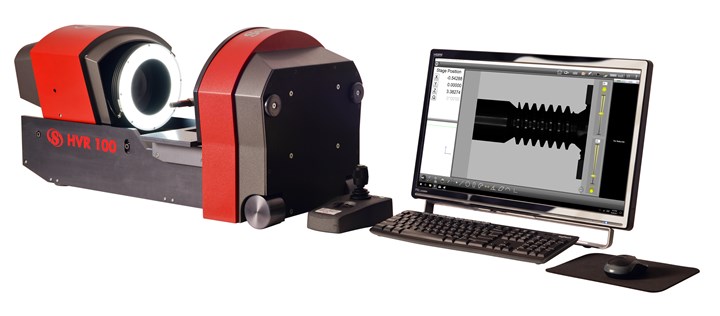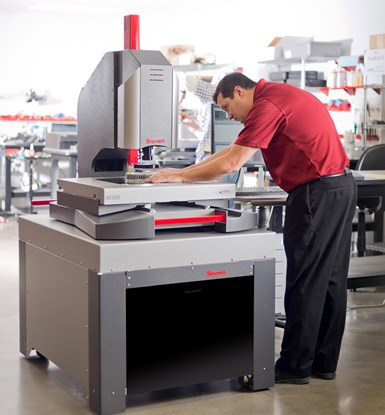This vision system is equipped with dual optical systems and touch-probe capability to measure parts with a range of feature sizes and geometries. Photo Credits: The L.S. Starrett Co.
Ensuring that stringent medical part quality specifications are met is challenging. Vision systems that offer a variety of options can help in this regard while speeding part measurement routines. However, this can make it arduous for shops to select the right vision system to meet their specific needs.
With the right vision system for an application, machine shops that produce medical parts can use this type of measurement and inspection technology to be confident in the quality of their final product. The L.S. Starrett Co., manufacturer of vision systems and other metrology equipment, suggests three steps shops should take to select the right vision system to meet their needs. CW Moran, marketing specialist, Metrology Division at The L.S. Starrett Co., has provided the information for this article.
Featured Content
First, shops should identify the range of parts requiring quality control and their corresponding requirements. Medical part specifications are often tight, requiring precise dimensions, printed documentation and part number tracing. Identifying these specs upfront helps to streamline the next step in the process.
Second, it’s important to consult with an experienced metrology system supplier that offers the latest vision system technology. Working with highly reflective finishes, complex curves, unique thread specifications and micro-etching are some realities of the medical device industry. Coordinating with a supplier that is knowledgeable about these distinctive challenges can help in selecting the right configurations with the proper lens, lighting, software and accessory options.
Proper setup of the vision system on a shop floor or quality control lab is also key. A reputable supplier works closely with its customers regarding installation and training during system integration on a shop floor. Providing ongoing technical support, either virtual or in person, for the lifetime of the vision system is critical as well. This may include help with annual calibration to ensure the system is operating consistently and reliably.
Third, shops should be aware of various vision system options. Today’s vision systems offer a range of capabilities which may be available as standard or can be configured for a customized system. A metrology system provider can guide users to choose the best options and functionality for an application. Here are a few to consider.
This large field-of-vision (FOV) benchtop vision measurement system — which is capable of being used in either a vertical or horizontal orientation — features a high-resolution digital video camera and minimal optical distortion for accurate FOV measurements of up to 90 mm (3.65").
Benchtop or floor-standing systems. Tabletop microscopes, horizontal and/or vertical view tabletop systems, and floor-standing models in horizontal or vertical viewing orientation are available.
CNC functionality. CNC is available as an option on almost every vision system. It can be used independently or in coordination with a touch probe to ensure the desired measurements are being taken at the exact point consistently.
Optical components. For most modern vision systems, taking measurement points in the Z axis is a standard feature or offered as an option. When combined with high-magnification optics, the system can capture numerous accurate data points in all three dimensions.
New multisensor measurement platforms may be equipped with dual optical systems that work in tandem to enable measurement of a range of features with one single device. A primary zoom lens enables small, intricate features to be inspected with high precision and resolution down to 2 microns. A range of zoom options also means that measurement configurations can be custom tailored to meet the specific application requirements for each user and enables companies to have only one metrology system without the need to change lenses or recalibrate the unit.
Touch probes. This capability increases the versatility of vision systems by providing an additional layer of tactile inspection, enabling the capture of discrete points on a part’s profile to be built into the inspection process as programmable steps. Discrete points that can be hard for a vision process to “see” can be accurately measured with the touch probe sensor by traveling into recessed spaces and measuring the required points.
Lighting. Good lighting ensures that highly reflective surfaces found on many medical devices do not interfere with obtaining accurate results. All lighting systems on vision systems can be adjusted for intensity, depending on the specific needs for measuring a part. Light levels can be integrated into the inspection process as programmable steps.
Camera. Customizable camera features have been developed to handle the challenges of intricate part inspection. Zoom lenses can produce up to 310X magnification on the monitor. Telecentric optics come in an array of lens
The walkup metrology process enables any employee to initiate a software program for a measurement system and instantly obtain consistent results after a part profile is created.
options from 0.14X to 4.00X. Systems such as the Starrett AVX550 which can be equipped with telecentric and zoom optics. This enables intricate part details and larger features to be inspected without changing lenses or recalibrating. In addition, the Starrett AVR-FOV comes equipped with a dedicated 2.3-inches by 1.9-inches field of view.
Software. Software can enhance the capabilities of a vision system, enabling part recognition profiles to be created based on a few key points of a component’s profile. Once this profile has been created, another part or multiple parts can be placed in the camera’s field of view to initiate the part recognition profile. The camera looks for specific part features to measure and automatically runs the preferred measurements, generating a report in seconds.
Accessories. Accessories — which include fixtures, vises and rotary indexers — can assist with proper part orientation. A rotary indexer is recommended for controlled rotation of a part while maintaining position, such as when a user is inspecting the leading edge of a bone screw thread.
RELATED CONTENT
-
Automated Inspection Transforms Medical Manufacturer’s Quality Control
Manual steps for part inspection have been eliminated with a new CMM process using more advanced software and strategies such as using a combined scanning/touch-trigger probe.
-
The Anatomy of a CNC Machine IoT Solution
Industry 4.0 is bringing sweeping changes to manufacturing and IIoT is one of its enabling technologies. Early adopters are reaping the benefits.
-
Exploring the Benefits of Reaming for Finishing Bores
How does reaming compare to single-point boring? A supplier of reaming tools compares these processes commonly used to finish bores and offers tips for those considering reaming.









